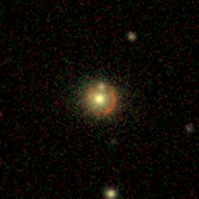what is this below middle radio and infre red signals
-
 by
cktwigg
by
cktwigg
Hi I am curious , I spent some time looking at the warp site yesterday , Im thinking that the blue ring around the
centre radio and infra red signals looks similar the the warp rings on the searching for galaxies site or am I way off markPosted
-
 by
JeanTate
in response to cktwigg's comment.
by
JeanTate
in response to cktwigg's comment.
Welcome to Radio Galaxy Zoo! 😃
The scale of the images here is quite different from that in Space Warps; for example, a typical IR circular blob is ~5" across, which is bigger than all but the most enormous lensed images.
Perhaps an example might help. Here is the same field as seen by SDSS (the size and orientation the same; the scale is very slightly different):
If there was a gravitational lens (GL) image, near the center, you'd be hard-pressed to spot it in this image.
Zooming in:
While I don't actually know the scale of the latest round of Space Warps images, I think this one is likely close.
No GL image.
So what about the blue? That's a representation of radio emission, detected by a special kind of radio telescope, quite different from the one that featured in the BBC’s Stargazing Live program the other day (yesterday). Could there be a GL image in 'the radio'?
In principle, yes.
One of the wonderful things about GLs is that they are achromatic: whatever you see in IR or optical images, you'd also see in UV, x-ray, microwave, radio ... images; the 'lensing' is done in exactly the same way, 'light' (electromagnetic radiation) is 'bent' by exactly the same amount, irrespective of its wavelength (GLs and ordinary lenses are quite different in this regard).
However, to 'see' a GL image in other parts of the electromagnetic spectrum (x-rays, say), the source (background galaxy) needs to be bright enough in x-rays that x-ray telescopes could detect it. For radio sources, that's generally not a problem. Then there's the question of resolution: can radio telescopes 'take images' in which you could 'see' a nice arc, ~1" across (say)? Yes, in principle they can. However, the radio telescope which took the radio images in RGZ does not have this resolution 😦 In fact, its resolution is about the same as that of WISE, which is used for the IR part of RGZ images.
Bottom line? Even if there are GLs in some RGZ images (and there surely must be), they will be unrecognizable, because they'd be too small to be resolved.
Back to the nice #doublelobe in ARG0002zdx *: it likely is caused by jets from the IR source just to the left of the left-most tip of the right-hand lobe. And that IR source is at the same position in the sky as SDSS J132111.38+110447.4, which is the fuzzy red blob in the zoomed-in image above (I cheated a bit: I moved the center of the SDSS image a bit, so that it falls on this galaxy, not the center of the bigger lobe). There's no SDSS spectrum of this distant galaxy, but its redshift has been estimated from its colors: 0.559 ± 0.0323 by one method, 0.565 ± 0.0946 by another. Also, there seems to be nothing in NED on this, ...
... so you were likely the first to 'see' it ... huge blobs of plasma, shooting out from the region around a super-massive black hole (with a mass likely in the billions of sols, billions of times the mass of our own Sun) at close to the speed of light (and far more powerful than the Large Hadron Collider), in a giant elliptical galaxy billions of light-years away.
How awesome is that!?! 😄
*ignoring the faint source right at the left-hand edge; that's likely an unrelated source
Posted
-
 by
cktwigg
by
cktwigg
Wow thanks that is very awsome Jean !! and thanks for your response which really helped me to understand
Posted
-
 by
JeanTate
in response to cktwigg's comment.
by
JeanTate
in response to cktwigg's comment.
You're more than welcome! 😃
You may have heard that the Zooniverse project Space Warps had a very successful few days last week, resulting - among other things - in the discovery of a very nice lens, '9io9'.
This lens provides an excellent opportunity to illustrate just how tiny most GLs are.
Here's the VICS82 iJK bands image, an enhanced zoomed-in version of what the zooites who found this lens saw ('VICS82' is the name of the survey; 'iJK' are the three infrared bands that are mapped to the BGR JPG image):

Pretty obvious, eh?
Now here's the same object as seen by DR10 SDSS:
You'd be very hard pressed to say there's an obvious lens-like feature in this image! Of course, one reason it's not obvious is that the background galaxy - the arcs - is barely detectable except in the K band, and the SDSS image does not contain K band data (it's entirely the gri bands). But the main reason is that the whole system is no more than ~5" across, which is the resolution limit of the shortest-wavelength WISE images, and of the radio ones too. So in WISE or FIRST, this system would look like a single circular blob (assuming it is a compact radio source; it's certainly a compact IR source).
Here's the last image, this time with a grid and scale:
Posted
-
 by
ivywong
scientist, admin
by
ivywong
scientist, admin
I'd like to second @cktwigg's thanks to Jean too. Very nice investigation and explanation 😃
Posted